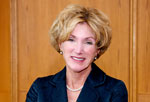The figures are irrefutable. Months after we enrolled our largest, most diverse and most academically accomplished class, an awe-inspiring 18,411 students applied to enroll as undergraduates in the fall of 2013. This figure represents a leap of 25 percent over 2012’s applications—and the highest total in our history.
3-D printing is more efficient, flexible and cost-effective than traditional manufacturing. The Case School of Engineering is capitalizing on its extensive expertise to co-lead America Makes, the National Additive Manufacturing Innovation Institute. The new national research center is supported through a $30 million federal grant, plus $40 million from partner organizations.
Starting college is all about taking on increased responsibility—a concept Professor Lee Thompson extends to her introductory SAGES (Seminar Approach to General Education and Scholarship) course for first-year students. Together, the class decides course topics, some assignments and off-campus trips. The result: impressive engagement—so impressive that Thompson earned national recognition with McGraw-Hill’s 2013 Award for Excellence in Teaching First-Year Seminars.
We'd hoped 618 alumni would take part in our first Day of Giving on June 18. We got 795. Their $195,745 in gifts in a single day smashed our one-day record. Even more, their generosity contributed to our all-time annual fund record of $10.3 million and one-year attainment record of $145.9 million.
When HR Magazine asked more than 11,000 human resources directors around the world to name the field’s leading minds, Weatherhead School of Management Professor Richard Boyatzis ranked No. 9 on a list that included Rosabeth Moss Kanter, Henry Mintzberg and Jeffrey Pfeffer. A New York Times best-selling author, Boyatzis has helped revolutionize management with research on emotional intelligence and other essential leadership traits.
Clean teeth and a clean bill of health? Thanks to a three-year pilot program that began in February, students from the Frances Payne Bolton School of Nursing and School of Dental Medicine provided 31 patients with dental exams, health screenings and immunizations during a single appointment. The program is a model for both inter-professional education and practice.
We’re growing up. And out. And becoming even more stunning. Consider our list of projects in the works: the $50 million, 89,000-square-foot Tinkham Veale University Center; a medical education building in partnership with Cleveland Clinic; a seven-story, 50,000-square-foot think[box] innovation lab; the Milton and Tamar Maltz Performing Arts Center at The Temple – Tifereth Israel; and the 24,000-square-foot, two-story Wyant Athletic and Wellness Center.
In 141 cases spanning civil, criminal, community development, intellectual property and health law, students in the Milton A. Kramer Law Clinic provided the community 16,040 pro bono hours of assistance—and learned skills through real-world practice.
Learn more about the law clinic.
The Jack, Joseph and Morton Mandel School of Applied Social Sciences consistently ranks among the nation’s best—in part because students get firsthand field experience with 350 affiliated Northeast Ohio social service agencies. Their 176,000 hours volunteered in just one year represent the equivalent of 90 full-time social workers.
Learn more about their field education.
At this university, we embrace our inner actor—and dancer...and musician...and designer...and more. During the past academic year, the curtain raised 110 times for on-campus recitals, plays, music and dance concerts. Nearly 800 students participated in programs through the College of Arts and Sciences—a total that inspires us to say, "Bravo!"
Learn more about our performing arts program.
The National Cancer Institute recognized the collaboration among 350 scientists at the Case Comprehensive Cancer Center with an "outstanding" rating and a $23 million grant. The center is a partnership led by our medical school and includes Cleveland Clinic and University Hospitals Case Medical Center.

Typically, readers find figures at the end of an annual report—in financial highlights, research statistics and the like. But as we looked back on 2012-2013, we saw that several of our most impressive accomplishments involved big numbers, among them: all-time records involving admissions and fundraising, landmark investment in manufacturing innovation and extraordinary acclaim for individual faculty members.
True, many of our most important experiences can never be quantified. No data point can capture the swell of excitement a student feels when a complex concept suddenly becomes clear. Or the energy unleashed when a faculty member makes a groundbreaking discovery. Or even the pure joy people feel when watching graduates march across the commencement stage.
And yet, sometimes numbers can be the best way to convey impact. It’s one thing to say this campus is trendy, as The Huffington Post observed in 2011. But when you hear that our undergraduate applications have more than doubled in the past five years, the scale of our appeal becomes far more apparent. Similarly, we long have touted the strength of our teaching, but now we can note we have the nation's No. 1 educator for first-year seminars.
Sometimes you really can think by numbers. And for Case Western Reserve in 2012-2013, they add up to a very big year.
Barbara R. Snyder
President